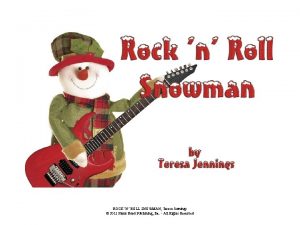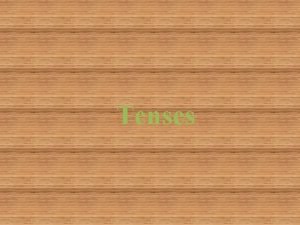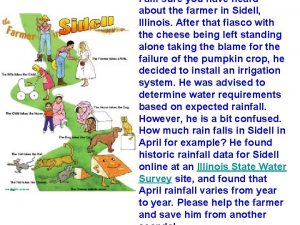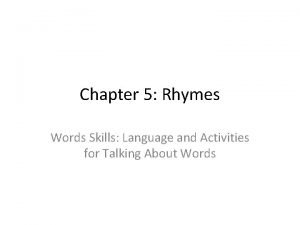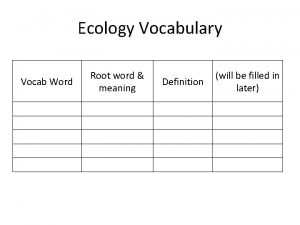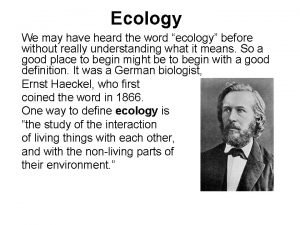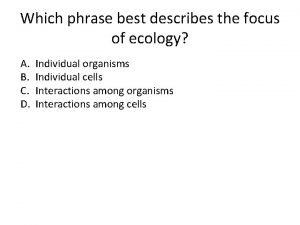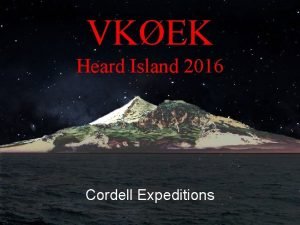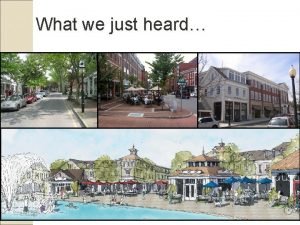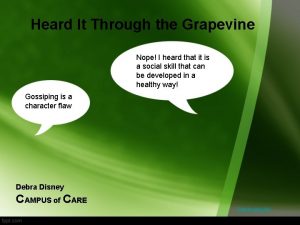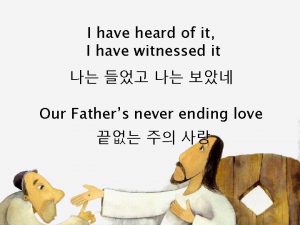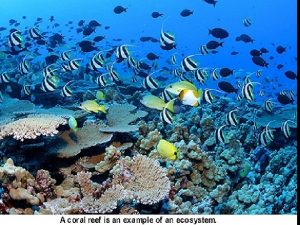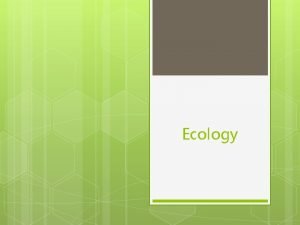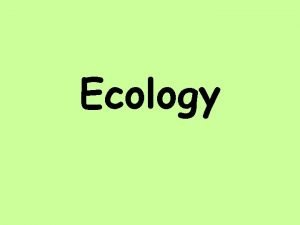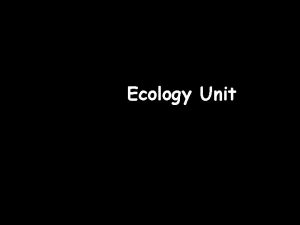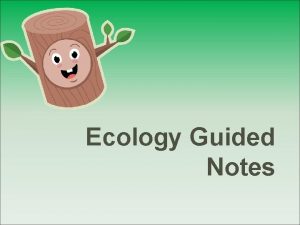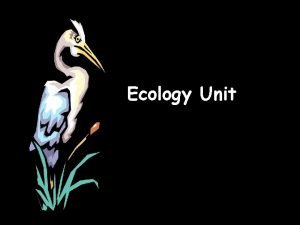Ecology We may have heard the word ecology





























- Slides: 29

Ecology We may have heard the word “ecology” before without really understanding what it means. So a good place to begin might be to begin with a good definition. It was a German biologist, Ernst Haeckel, who first coined the word in 1866. One way to define ecology is “the study of the interaction of living things with each other, and with the non-living parts of their environment. ”

Ecology The word “ecology” comes from the Greek words oikos meaning “the place where one lives, ” and logos which means “study of. ”

Organism Animal and plants are examples of living things in our environment. If we focus on just one example of a living thing, we can use the word organism to represent that single life form. For example a frog is an organism.

Biotic Factors In ecology living things that affect other living things are called biotic factors. For example, biotic factors that might influence the life of this frog could be the plant life around it, or possibly animals such as snakes that might eat it.

Abiotic Factors There also parts of our environment that are not living. In ecology the non-living things that affect living things are called abiotic factors. For example, abiotic factors that might influence the life of this frog could be the amount of sunlight, the air temperature, and how strong the wind is.

Population Living things usually do not live by themselves. Living things often live together with other members of their own species. The term population refers to all members of the same species that live in the same ecosystem or habitat.

Population of Frogs In our example, all the frogs in a habitat would be referred to as a population of frogs. The photo below shows a population of 4 frogs.

The Thin Green Line • https: //www. youtube. com/watch? v=n. Bbkwl. G M 7 X 0

More Than Just Frogs Any place that an ecologist is studying usually has more than one species living in it. So for example a pond may have more than just frogs. It may also have mosquito larvae, tadpoles, minnows, algae, and plants and animals of various kinds.

Community There is a name given to all the populations of species in an ecosystem. We call this a community. All those plants and animals that live with the frog are part of the community in the pond.

Studying a Community When a scientist studies a community, he might want to learn about how biotic factors affect the community. For example, in studying a pond community, the scientist may want to know how plants and animals in the community affect each other.

Ecosystem Now suppose that the scientists wants to study more than the populations in a community. He may also want to study how physical systems such as sunlight and rain affect the populations. Now we can say that he is studying an ecosystem.

Ecosystem Here is more of a text book definition of an ecosystem. An ecosystem is a specific place defined by an ecologist where there is an interaction between populations of species. It is also the interaction between those populations and the non-living (abiotic) factors in the environment.

Ecotone There is not a sharp boundary from one ecosystem to the next. For example, the diagram shows a pond ecosystem to the left and a field ecosystem on the right. But there is a region between them that has some characteristics of both. The transition area between two ecosystems is called an ecotone.

Transition Areas The ecotone in this example may have frogs or mosquitos that are also found mainly in the pond area. It may also have racoons and butterflies that are found mainly in the field ecosystem. These ecotone areas are rich in different species. We can say that they have a high degree of biodiversity.

Diversity in the Ecotone The ecotone in this example may have frogs or mosquitos that are also found mainly in the pond area. It may also have racoons and butterflies that are found mainly in the field ecosystem.

Biosphere Now let’s take a much larger view. The biosphere is a thin layer of air, land, and water on or near Earth’s surface in which all living things on Earth exist. It is a global sum of all ecosystems. If an apple represented Earth, the biosphere would be thickness of the apple’s peal. The diagram at the right shows how the term “biosphere” is related to other terms in ecology.

Biome The biosphere represents all of Earth and an ecosystem is one small part of the biosphere. Ecologists also study larger parts of the biosphere called biomes. A biome is a large region within a biosphere that has similar biotic and abiotic components. For example, much of Manitoba is covered by the Boreal Forest biome.

Western Hemisphere Biomes The diagram at the right shows the major biomes in the Western Hemisphere.

Habitat Now we turn from a large area to a small one. A habitat is the place in which an organism lives. For example, a red-backed salamander makes its nest in the decaying wood of a fallen tree. For a frog, it could be a pond. The diagram shows how a habitat, and ecosystem, and a biome are related to each other.

Checklist 1. Define the following terms: ecology, organism, biotic factors, abiotic factors, population, community, ecosystem, ecotone, biodiversity, biosphere, biome, habitat 2. List examples of biotic and abiotic factors in an environment.

Practice 1. The following are partial definitions of important terms in ecology. For each one, complete the sentence. a) Ecology is defined as the study of the interaction of living things with each other, and with the non-living parts of their environment. b) Biotic factors are living things that affect other living things. c) An organism is a single life form. d) Abiotic factors are the non-living parts of our environment that affect living things. e) A population refers to all members of the same species that live in the same ecosystem or habitat. f) A community is made up of all the populations of species in an ecosystem.

Practice g) An ecosystem is a specific place defined by an ecologist where there is an interaction between populations of species. It is also the interaction between those populations and the non-living (abiotic) factors in the environment. h) An ecotone is the transition area between two ecosystems. i) A high degree of biodiversity refers to the richness of different species in an area, especially in an ecotone. j) The biosphere is a thin layer of air, land, and water on or near Earth’s surface in which all living things on Earth exist. k) A biome is a large region within a biosphere that has similar biotic and abiotic components. l) A habitat is the place in which an organism lives.

Practice 2. In defining ecology, we make use of two root Greek words. What are these two root words and what do they mean? The word “ecology” comes from the Greek words oikos meaning “the place where one lives, ” and logos which means “study of. ”

Practice 3. Jimmy has a backyard vegetable garden. He is learning about how plants grow and about where his food comes from. For this garden, what would an example of a “population” and how would it be different from a “community? ” The word “population” could be applied to all the vegetables of one kind, for example, all the carrots in the garden. The word “community” would be applied to all the living things in the garden such as all the other vegetables and plants (possibly weeds), any animals that may live there (insects such as butterflies, earthworms, and so on).

Practice 4. This is a photograph of Assiniboine Forest in Winnipeg. You can see some trees. What are two examples of biotic factors and two examples of abiotic factors that can affect the lives of trees in this area? There are many possible answers here. Two examples of biotic (living) factors could be other plants around the trees competing for soil nutrients, or animals such as deer that may use part of the tree for food. Two examples of abiotic (non-living) factors could be the amount of sunlight or rain that the trees receive.

Practice 5. Where would you likely Find more species, a forest, an open field, or the forest-grassland ecotone between them? You would most likely find the greatest diversity in the forest-grassland ecotone. There will be some species from both ecosystems in this transition area between the two ecosystems.

Practice 6. The diagram at the right shows the changes in population growth of one-celled organisms called paramecia. Look at the number of paramecia in Beaker A And Beaker B towards the end of the recorded time. Now look at Beaker C. What evidence is there that shows that the populations of paramecia affect each other? For both populations 1 and 2, there are fewer numbers of paramecia than was the case when they lived in separate containers. This is especially the case for Species 2 whose numbers have gone down by a large amount.

Practice 7. Abiotic factors can determine what life exists in an ecosystem. Go to the following site: https: //www. youtube. com/watch? v=7 Wfs 2 L 5 Iyd. Y The video shows examples of how the abiotic factor water determines life in ecosystems. Give at least two examples shown in the video. A lack of water in the desert means that camels and cacti live there. A great deal of water would be required for a hippopotamus. Also ocean fish require salt water while river fish live in fresh water.
 Snow snow snow teresa jennings
Snow snow snow teresa jennings Have you heard the sound of the angel voices
Have you heard the sound of the angel voices Have heard tense
Have heard tense You have probably heard
You have probably heard I am sure you have heard something like
I am sure you have heard something like Would alexander have heard of jesus
Would alexander have heard of jesus What comes to your mind when you hear the word work
What comes to your mind when you hear the word work What comes to your mind if you hear the word institution
What comes to your mind if you hear the word institution Beware of heard a dreadful word
Beware of heard a dreadful word It has 5 faces 8 edges 5 vertices
It has 5 faces 8 edges 5 vertices Ecology vocab
Ecology vocab The word ecology
The word ecology Which phrase best describes
Which phrase best describes Building vocabulary: word roots - ecology
Building vocabulary: word roots - ecology Hci patterns may or may not include code for implementation
Hci patterns may or may not include code for implementation Hình ảnh bộ gõ cơ thể búng tay
Hình ảnh bộ gõ cơ thể búng tay Lp html
Lp html Bổ thể
Bổ thể Tỉ lệ cơ thể trẻ em
Tỉ lệ cơ thể trẻ em Chó sói
Chó sói Chụp tư thế worms-breton
Chụp tư thế worms-breton Hát lên người ơi alleluia
Hát lên người ơi alleluia Môn thể thao bắt đầu bằng chữ f
Môn thể thao bắt đầu bằng chữ f Thế nào là hệ số cao nhất
Thế nào là hệ số cao nhất Các châu lục và đại dương trên thế giới
Các châu lục và đại dương trên thế giới Công thức tính thế năng
Công thức tính thế năng Trời xanh đây là của chúng ta thể thơ
Trời xanh đây là của chúng ta thể thơ Cách giải mật thư tọa độ
Cách giải mật thư tọa độ Làm thế nào để 102-1=99
Làm thế nào để 102-1=99 Phản ứng thế ankan
Phản ứng thế ankan
